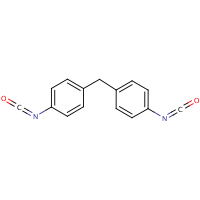Methylenediphenyl diisocyanate
Agent Name
Methylenediphenyl diisocyanate
Alternative Name
MDI
CAS Number
26447-40-5
Formula
C15-H10-N2-O2
Major Category
Plastics & Rubber

Synonyms
4,4'-,2,4'-,2,2'-Diisocyanatodiphenylmethane; Diphenylmethane diisocyanate; Isocyanic acid, methylenediphenylene ester; Benzene, 1,1'-methylenebis(isocyanato-; Crude MDI; Generic MDI; Non-isomeric-specific MDI; [ChemIDplus] 1,1'-Methylenebis(isocyanatobenzene); 2,4'/4,4'-Diphenylmethandiisocyanat; Difenilmetanodiisocianato; Diphenylmetha-4,4'-diisocyanat; Diphenylmethane-4,4'-diisocyanate and isomers; Diphenylmethane-4,4'-diisocyanate; Isocyanic acid, methylenediphenylene ester; MDI; MDI-Gemisch; Methyldiphenyldiisocyanat; [IUCLID] Methylenebis (phenyl isocyanate); [Official Journal of the European Union] MONDUR ML; [Bayer Material Science MSDS] UN3082
Category
Diisocyanates
Description
Polymeric MDI: Dark amber viscous liquid; Pure 4,4'-MDI: White waxy solid; [CPS&Q: RARs - Final Report] Light to dark yellow liquid with a mild musty odor; mp = 15-20 deg C; [Bayer Material Science MSDS]
Sources/Uses
Used in the furniture, car, shoe, carpet, refrigerators and freezers, textile, coatings, and construction industries; [IUCLID] Used primarily in the manufacture of rigid polyurethane foams; Other uses include coatings, adhesives, sealants, elastomers, paints, footwear, (semi) flexible and thermoplastic polyurethane foams, polyurethane fibers, and to make particle board and foundry mould cores; [CPS&Q: RARs - Final Report]
Comments
This CAS refers not only to isomeric mixtures but also all the specific isomers including those with unique CAS numbers; A skin, eye, and respiratory tract irritant; Allergic contact dermatitis, contact urticaria, asthma, and hypersensitivity pneumonitis reported from occupational exposure; Long term occupational inhalation exposure has demonstrated decreased ventilatory function and respiratory symptoms even at levels below current guidelines; [CPS&Q: RARs - Final Report] Causes contact urticaria; [Kanerva, p. 219] Reacts slowly with water evolving carbon dioxide; An irritant; May cause skin and respiratory sensitization; Inhalation overexposure may cause bronchitis, bronchial spasm, and pulmonary edema; [Bayer Material Science MSDS] See "Methylene bisphenyl isocyanate."
Reference Link #1
Biomedical References
Exposure Assessment
Vapor Pressure
4E-06 mm Hg
Odor Threshold Low
0.4 ppm
RD50
3.125 ppm
Lethal Concentration
LC50 (rat) = 369 mg/m3/4hr
Explanatory Notes
Odor threshold from IUCLID; The Guide in the Emergency Response Guidebook is for "Other regulated substances, liquid, n.o.s."
Adverse Effects
Skin Sensitizer
Yes
Asthma
Yes
Toxic Pneumonitis
Yes
Fibrogenic
Yes
IARC Carcinogen
Not classifiable
Diseases, Processes, and Activities Linked to This Agent
Diseases
Occupational diseases associated with exposure to this agent:
Processes
Industrial Processes with risk of exposure: